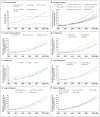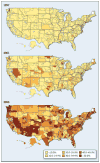Growth in the care of older patients by hospitalists in the United States
- PMID: 19279342
- PMCID: PMC2977939
- DOI: 10.1056/NEJMsa0802381
Growth in the care of older patients by hospitalists in the United States
Abstract
Background: National and population-based information on the increase in patient care by hospitalists in the United States is lacking.
Methods: Using a 5% sample of Medicare beneficiaries in 1995, 1997, 1999, and the period from 2001 through 2006, we identified 120,226 physicians in general internal medicine who were providing care to older patients in 5800 U.S. hospitals. We defined hospitalists as general internists who derived 90% or more of their Medicare claims for evaluation-and-management services from the care of hospitalized patients. We then calculated the percentage of all inpatient Medicare services provided by hospitalists and identified patient and hospital characteristics associated with the receipt of hospitalist services.
Results: The percentage of physicians in general internal medicine who were identified as hospitalists increased from 5.9% in 1995 to 19.0% in 2006, and the percentage of all claims for inpatient evaluation-and-management services by general internists that were attributed to hospitalists increased from 9.1% to 37.1% during this same period. Accompanying the increase in care by hospitalists was an increase in the percentage of all hospitalized Medicare patients who were treated by general internists (both hospitalists and traditional, non-hospital-based general internists), from 46.4% in 1995 to 61.0% in 2006. In a multilevel, multivariable analysis controlling for patient and hospital characteristics, the odds of receiving care from a hospitalist increased by 29.2% per year from 1997 through 2006. In 2006, there was marked geographic variation in the rates of care provided by hospitalists, with rates of more than 70% in some hospital-referral regions.
Conclusions: These analyses of data from Medicare claims showed a substantial increase in the care of hospitalized patients by hospitalist physicians from 1995 to 2006.
2009 Massachusetts Medical Society
Conflict of interest statement
Dr. Sharma reports receiving lecture fees from Pfizer. No other potential conflict of interest relevant to this article was reported.
Figures




Comment in
-
The growth of hospitalists and the changing face of primary care.N Engl J Med. 2009 Mar 12;360(11):1141-3. doi: 10.1056/NEJMe0900796. N Engl J Med. 2009. PMID: 19279346 No abstract available.
-
Growth in care provided by hospitalists.N Engl J Med. 2009 Jun 25;360(26):2789-90; author reply 2790-1. doi: 10.1056/NEJMc090754. N Engl J Med. 2009. PMID: 19553655 No abstract available.
-
Growth in care provided by hospitalists.N Engl J Med. 2009 Jun 25;360(26):2790; author reply 2790-1. N Engl J Med. 2009. PMID: 19557888 No abstract available.
References
-
- Coffman J, Rundall TG. The impact of hospitalists on the cost and quality of inpatient care in the United States: a research synthesis. Med Care Res Rev. 2005;62:379–406. - PubMed
-
- Freed D. Hospitalists: evolution, evidence, and eventualities. Health Care Manag (Frederick) 2004;23:238–56. - PubMed
-
- Wachter RM, Goldman L. The emerging role of “hospitalists” in the American health care system. N Engl J Med. 1996;335:514–7. - PubMed
-
- Society of Hospital Medicine releases results of the 2007–2008 survey on the state of hospital medicine movement. Philadelphia: SHM; 2008. [Accessed February 17, 2009]. at http://www.hospitalmedicine.org/AM/Template.cfm?Section=Home&TEMPLATE=/C....
-
- Lindenauer PK, Pantilat SZ, Katz PP, Wachter RM. Hospitalists and the practice of inpatient medicine: results of a survey of the National Association of Inpatient Physicians. Ann Intern Med. 1999;130:343–9. - PubMed
Publication types
MeSH terms
Grants and funding
LinkOut - more resources
Full Text Sources
